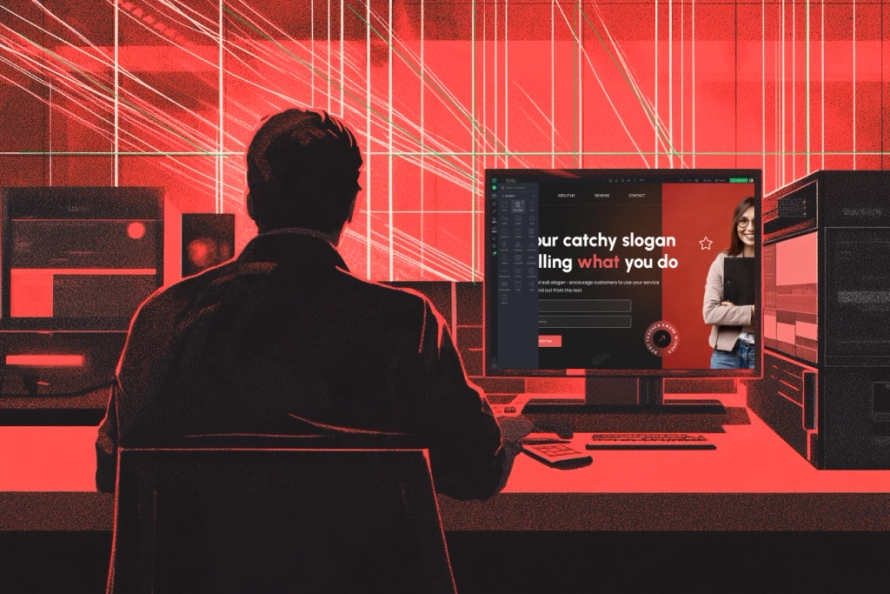Just How to Successfully Incorporate Looks and Performance in Website Design
When creating a site, you need to strike a balance between looks and performance. It's not just regarding looking great; your style should additionally serve a purpose and guide individuals successfully. By concentrating on simplicity and user-friendly navigation, you can create an appealing experience. Yet what elements absolutely enhance functionality while maintaining aesthetic allure? Let's discover the crucial concepts that can lead to an unified mix of appeal and feature.
Recognizing the Relevance of Aesthetic Appeals and Performance
When you create an internet site, comprehending the balance between visual appeals and performance is necessary for developing an effective customer experience. An aesthetically enticing site grabs interest, however it's the capability that keeps users engaged. Site visitors will swiftly shed rate of interest and leave.Consider your target audience and what attracts them in if your site looks terrific yet is challenging to navigate. You want to develop a style that reflects your brand name while making sure ease of use. Structured layouts, user-friendly navigating, and clear phone calls to action can improve both appearances and performance.

Concepts of Reliable Web Style
To produce an efficient web design, you require to adhere to a number of key concepts that boost both customer experience and visual allure. Initially, focus on simpleness; a tidy layout aids customers browse quickly. Utilize a constant color scheme and typography to preserve comprehensibility throughout your website. This fosters experience and trust.Next, guarantee your design is responsive. Users accessibility web sites on different tools, so your design must adapt perfectly. Take notice of visual power structure; highlight crucial aspects with shade, positioning, or size to lead customers' focus.Finally, incorporate sufficient white space. It stops clutter and makes content extra digestible. Remember, reliable internet design balances appearances and functionality, so every design choice must offer a function. By complying with these concepts, you'll develop a site that's not only visually appealing yet additionally user-friendly, inevitably keeping visitors engaged and urging them to return.
Focusing On Individual Experience
When prioritizing user experience, you'll desire to begin by recognizing what your customers really need. Simplifying navigation style can make a massive difference in exactly how conveniently they find what they're trying to find. Likewise, enhancing visual hierarchy aids assist their focus to the most crucial aspects on your website.
Comprehending Customer Demands
Comprehending user demands is necessary for producing an appealing web experience that maintains visitors coming back. To accomplish this, you must identify the objectives and choices of your target market. Beginning by carrying out user study, like surveys or interviews, to gather insights on what users value most. Focus on their discomfort factors and obstacles when communicating with similar internet sites. This details allows you to tailor your style, making sure performance aligns with user assumptions. Furthermore, take into consideration creating customer personalities that stand for different sections of your audience, assisting you envision their demands throughout the design procedure. When you prioritize recognizing user demands, you develop a web site that not only looks terrific but additionally supplies a seamless, enjoyable experience that cultivates loyalty.
Streamlining Navigating Layout

Enhancing Visual Power Structure
A solid visual pecking order is important in guiding users with your site and guaranteeing they engage with crucial content. To accomplish this, utilize shade, spacing, and dimension tactically. Make important components like headings bigger and bolder than body message, attracting focus instantly. Use contrasting colors to highlight phone calls to action, motivating clicks. In addition, employ adequate white area to separate areas, making content absorbable and inviting.Consider the flow of information; prepare components practically, leading individuals' eyes from one indicate the following. Use aesthetic hints, like arrowheads or lines, to guide interest. By focusing on visual hierarchy, you boost customer experience and boost the possibility of conversions, ensuring your web site is both cosmetically pleasing and functionally reliable.
Color Concept and Its Influence On Usability
While selecting the appropriate shades for your internet site might feel like a minor information, it substantially affects usability and individual experience. Color impacts how customers perceive info and can boost or prevent navigating. For example, contrasting colors can aid important elements attract attention, making it easier for visitors to discover what they need.Additionally, think about the psychology of shades: blue frequently motivates depend on, while red produces seriousness. Understanding your target audience can direct your color selections, assuring they reverberate well.Moreover, regular shade schemes aid construct brand name identification, making your web site more memorable. Nevertheless, be careful-- a lot of shades can overwhelm individuals. Stay with a restricted palette that complements your material and keeps clarity.Incorporating accessibility is likewise necessary; confirm your color mixes get along for those with aesthetic disabilities. By thoughtfully using color concept, you'll boost usability and develop a much more interesting user experience.
Typography: Balancing Style and Readability
Shade selections set the stage for your website, yet typography plays an equally vital duty in enhancing individual experience. You want your message to communicate clearly while additionally reflecting your brand name's individuality. Beginning by selecting typefaces that are not just attractive yet additionally understandable. Sans-serif fonts often work well for digital screens, as they're easier to read at numerous sizes.Maintain a power structure by utilizing various typeface sizes and weights; this overviews users with your web content easily. Consider line spacing and letter spacing; too tight can irritate viewers, while as well loose can interfere with the circulation. Limit your font options to two or 3 to maintain the style cohesive.Finally, constantly check your typography throughout various gadgets and internet browsers. What looks great on one display may out another. Stabilizing style with readability assurances that your message resonates, keeping your target market engaged and informed.
Receptive Style: Making Aesthetics Work on All Gadgets
To assure your website looks great on any kind of gadget, you'll require to embrace responsive style principles. This technique warranties your site adapts to numerous display dimensions, providing a suitable customer experience. Start by making use of fluid grids and versatile photos that scale effortlessly. Instead of fixed dimensions, opt for portions and relative systems, permitting your design to change dynamically.Next, carry out media queries in your CSS. These let you use different designs based on gadget qualities, like display size. In this manner, you can preserve aesthetic allure while guaranteeing functionality.Don' t neglect about touch targets; make certain buttons and web links are simple to touch on smaller displays. Focus on essential material, so individuals can conveniently navigate your website regardless of their device. By concentrating on these aspects, you'll produce an appealing, visually appealing experience that satisfies the demands of all users, whether they're on a smartphone, tablet, or desktop computer .
Carrying Out Functionality Screening for Continuous Enhancement
To enhance your website design, you require to set clear functionality goals that straighten with customer needs. By performing individual examinations, you can gather beneficial feedback on how actual individuals connect with your site. Analyzing these results will assist you make notified enhancements and create a much more reliable customer experience.
Defining Use Goals
While appearances can draw users in, defining usability goals is crucial for guaranteeing their experience continues to be satisfying and seamless. Beginning by identifying what you desire customers to achieve on your website (website design london Ontario). Consider their tasks, demands, and actions. Are they seeking info, purchasing, or enrolling in an e-newsletter? Establish clear standards to determine success, like task completion rates or time on task. Focus on instinctive navigating, obtainable content, and responsive design to enhance usability. Routinely revisit these objectives as customer assumptions progress. By specifying functionality goals, you develop a framework for assessing and improving your website's efficiency. This concentrate on functionality not only improves customer fulfillment yet additionally reinforces the total performance of your design
Carrying Out Customer Tests
Performing user examinations is important for refining your website and guaranteeing it fulfills your audience's needs. Start by identifying your target users and creating an examination strategy that describes your goals. Utilize a mix of measurable and qualitative approaches, such as surveys, interviews, and task-based observations, to gather detailed responses. Welcome participants to browse your site while you observe their interactions and note any type of difficulties they encounter. Urge open discussion to catch their thoughts and sensations regarding the design and functionality. Keep sessions brief and focused, guaranteeing you cover crucial areas without frustrating individuals. Make sure to record all findings, as this info will be important for making informed design decisions that improve both visual appeals and usability.
Examining Examination Outcomes
Just how can you efficiently analyze the outcomes of your usability examinations to drive constant renovation? Start by classifying comments right into common styles. Look for patterns in customer habits that highlight discomfort points or areas for enhancement. Usage quantitative information, like task completion rates and time on job, to measure functionality objectively. Don't neglect to take into consideration qualitative insights from customer comments; they commonly expose underlying issues that numbers can not show. Focus on one of the most impactful searchings for and produce actionable items for your layout team. Remember, it has to do with repeating-- execute adjustments, after that examination again. This cycle of screening, assessing, and refining helps you equilibrium aesthetic appeals and performance, ensuring your web site fulfills customer needs properly while keeping visual allure.
Often Asked Questions
Exactly how Do I Pick the Right Shade Scheme for My Web site?
To choose the appropriate shade scheme for your internet site, consider your brand's individuality, target market, and psychological influence (website design london Ontario). Use shade psychology, create consistency, and assurance readability. Examination mixes to see what resonates finest with visitors
What Tools Can Assist With Internet Style Visual Appeals and Functionality?
You can make use of devices like Adobe XD, Figma, and Lay out to boost your internet style's visual appeals and performance. These platforms supply instinctive interfaces, partnership functions, and pre-made design templates to improve your creative process and enhance your styles.
Exactly How Can I Include Animations Without Compromising Capability?
To integrate animations without endangering capability, focus on refined impacts that improve individual experience. Use CSS animations for smoother communications, assurance fast load times, and test on various tools to maintain efficiency while including aesthetic charm.
What Are Common Mistakes to Stay Clear Of in Website Design Looks?
When developing, stay clear of chaotic formats, inadequate color read more options, and inconsistent typefaces. Don't forget mobile responsiveness, as it can alienate individuals. Confirm your style lines up with your brand name, creating a seamless experience that involves site visitors successfully.
Just how Typically Should I Update My Site's Style for Optimal Appearances?
You must upgrade your website's style every 1-2 years to stay up to date with patterns and maintain optimal looks. Consistently restoring visuals aids involve site visitors and guarantees your site continues to be attractive and easy to use. When you design an internet site, understanding the balance in between aesthetics and functionality is crucial for creating an efficient customer experience. To create an efficient internet layout, you need to adhere to numerous vital concepts that enhance both customer experience and aesthetic charm. Customers access web sites on various gadgets, so your design should adjust flawlessly. When focusing on customer experience, you'll desire to begin by comprehending what your users absolutely need. Beginning by carrying out customer study, like interviews or studies, to gather understandings on what customers worth most.